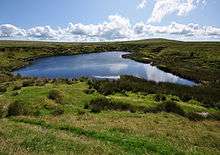Mire

A mire or quagmire, sometimes called a peatland, is a wetland terrain without forest cover dominated by living, peat-forming plants. For botanists and ecologists, the term peatland is a more general term for any terrain dominated by peat to a depth of at least 30 cm (12 in), even if it has been completely drained (i.e., a peatland can be dry, but a mire by definition must be wet).
There are two types of mire – fens and bogs. A bog is a domed-shaped land form, is higher than the surrounding landscape, and obtains most of its water from rainfall (i.e., is ombrotrophic) while a fen is located on a slope, flat, or depression and gets its water from both rainfall and surface water.
Also, while a bog is always acidic and nutrient-poor, a fen may be either slightly acidic, neutral or alkaline and either nutrient-poor or nutrient-rich.[1] A mire is distinguished from a swamp by its lack of a forest canopy (though some bogs may support limited tree or bush growth, mires are dominated by grass and mosses), and from a marsh by its water nutrients and distribution (marshes are characterized by nutrient-rich stagnant or slow-moving waters; mire waters are located mostly below the soil surface level) as well as its plant life (marsh plants are generally submerged or floating-leaved; those in a mire are not).[2]:p.13
Because mires rely on rainwater for nutrient input, they are usually deficient in both nitrogen and phosphorus, though they may vary widely with regard to nitrogen.[2]:p.14 These things mean that mires are a kind of "...living relic... [A] living skin on an ancient body"[3] in which successive layers of regular plant growth and decay are preserved stratigraphically with a quality of preservation unknown in other wetland environments.
Quagmire
The term quagmire is a variant term for a mire, the prefix quag- having been variously written as qua-, quab-, quad-, quake-, qual-, quave-, and quaw- in the 16th and 17th centuries, and afterwards the prefixes bob-, gog-, and wag- having also been used in the same way. The relationship between these terms is not linguistically clear though they may all have been an attempt to express the same general idea of shaky, wet, unsteady ground which could not support the weight of a man or large animal and was therefore dangerous to enter and difficult to leave.[4]
References
- ↑ Geist, Helmut (2006). Our Earth's Changing Land: An Encyclopedia of Land-Use and Land-Cover Change. 2. Greenwood. p. 463. ISBN 9780313327841.
- 1 2 Richardson, Curtis J.; Huvane, Jacqueline K. (2008). "Chapter 2: Ecological status of the Everglades: environmental and human factors that control the peatland complex on the landscape". In Richardson, Curtis J. The Everglades Experiments: Lessons for Ecosystem Restoration. Springer. ISBN 9780387689234.
- ↑ Goodwille, Roger (1981). "Peatlands: living relics". Naturopa. Strasbourg: European Information Centre for Nature Conservation of the Council of Europe (19). OCLC 605722266.
- ↑ Oxford English Dictionary (2nd ed.). Oxford University. 1989.
External links
| Look up quagmire, mire, or peatland in Wiktionary, the free dictionary. |